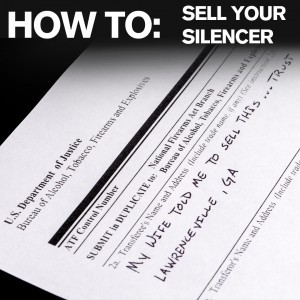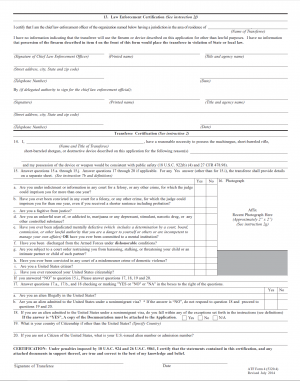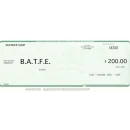February 23, 2016
 Have you ever wondered about selling your used silencer to a private party?
If you've owned guns for any amount of time - you know that used firearms are often in high demand. As a result, the market is healthy for these firearms and you can often get as much (or more) than you originally paid.
Unfortunately, the suppressor market isn't that way at all; and a used suppressor doesn't hold its value as well as a used firearm would.
In this article, we're going to go through the process of selling a silencer to a private party. Here are the things to consider if you decide to sell your used suppressor:
Have you ever wondered about selling your used silencer to a private party?
If you've owned guns for any amount of time - you know that used firearms are often in high demand. As a result, the market is healthy for these firearms and you can often get as much (or more) than you originally paid.
Unfortunately, the suppressor market isn't that way at all; and a used suppressor doesn't hold its value as well as a used firearm would.
In this article, we're going to go through the process of selling a silencer to a private party. Here are the things to consider if you decide to sell your used suppressor:
Make Sure the Buyer is Legal to Own Your Suppressor
This may seem obvious; but, there are some weird rules involved in the buying and selling of suppressors.- A person must be 21 years old to purchase a silencer from a dealer; but, they only have to be 18 to purchase from a private party. I have no idea what the logic is behind this, except to say "it's the government so it doesn't have to make sense."
- The buyer must not have any felony convictions - or convictions involving violent crimes. Don't worry about them fooling you because the NFA Branch will take a careful look at the paperwork before approving anything.
- Although it is possible to sell to a person who isn't in your state (as we'll mention later), it generally isn't worth it for either party. Once again, we'll talk more about this restriction in a bit.
The Buyer Should Reside in the Same State as the Seller
The main reason for this is financial; so, if you have a high-value collectors item - this general rule may not apply. Basically, if you sell to a person in your state you'll only need to submit a Form 4 directly from you to the buyer. If the buyer is in another state, you'll need to do a Form 4 to an FFL/SOT (i.e. Class 3) license holder in that state - and then the FFL will have to do another Form 4 from them to the buyer. Keep in mind that each Form 4 (even to a dealer) requires a $200 tax stamp payment as well as an NFA wait period. On top of that, most FFLs will expect to charge a transfer fee for this service. It's common to transfer a high-value machine gun to another state - which requires 2 tax stamps; but, the value of suppressors typically isn't high enough to justify this double-whammy. Also, please keep in mind that the double Form 4 does NOT apply if you purchase from an FFL/SOT license holder in another state. In this case, the suppressor can be transferred between dealers without a tax stamp payment using a Form 3.The Paperwork isn't that Difficult
When you sell your suppressor, you'll be acting as a dealer and will need to fill out the same Form 4 that was probably filled out by a dealer when you got your suppressor. Fortunately, you can use your existing Form 4 as a 'cheat sheet' when filling out the new form. Although we expect the Form 4 to change when ATF 41F goes into effect, here are some basic instructions on filling it out:- When you got the suppressor you were the transferee (listed in Section 2); but, as the seller you will now be the transferror (listed in Section 3). What this means is you should copy your information from Section 2 on the old form to Section 3 on the new form.
- Find out how the buyer wants to register, then fill out their information in Section 2. Remember to use the entity name if they're registering as a trust or corporation - in those cases, the buyers actual name won't show up anywhere on the new Form 4.
- Copy the exact information from Section 4 of your Form 4 to Section 4 on the new form. The NFA Branch is pretty picky here, so don't try to save time by using abbreviations (unless they're used on the form you already have).
- You should leave sections 5 through 8 blank unless you're selling to somebody with either an FFL or an FFL & SOT. If you are transferring to an out-of-state FFL holder, then fill in section 5 & 7 with their license information.
- Go ahead and circle the 'I Do' in section 9 so the buyer can call the NFA Branch directly to get status updates.
- Finally, you should sign in box 10, write your name and title in box 11, and sign in box 12.
- The Form 4 MUST be printed as a 2-sided document or the NFA Branch will send it back. This is the most common mistake we've seen with individual purchases.
- You should print 2 copies of the Form 4 and ensure both copies have original ink signatures. It doesn't work to fill it out once and then make a photo copy for the second copy.
 Once you've filled out the front of both Form 4 copies, you can hand it over to the buyer to take care of the back. If they're purchasing a silencer using either a trust or corporation then there isn't anything to do - they don't even need to sign the certification.
If they're purchasing as an individual, just keep it simple and have them fill out the entire back of the Form 4. Section 13 (Law Enforcement Certification) should be filled out by their local Chief Law Enforcement Officer (CLEO); but, keep in mind that this is typically a huge source of errors - which is why we review all individual applications after they've been signed by the CLEO.
Also, remember that the Transferee Certification section MUST be filled out for all SBR and Machine Gun transfers - although it can be skipped for suppressors if you're registering using a trust or corporation.
Once you've filled out the front of both Form 4 copies, you can hand it over to the buyer to take care of the back. If they're purchasing a silencer using either a trust or corporation then there isn't anything to do - they don't even need to sign the certification.
If they're purchasing as an individual, just keep it simple and have them fill out the entire back of the Form 4. Section 13 (Law Enforcement Certification) should be filled out by their local Chief Law Enforcement Officer (CLEO); but, keep in mind that this is typically a huge source of errors - which is why we review all individual applications after they've been signed by the CLEO.
Also, remember that the Transferee Certification section MUST be filled out for all SBR and Machine Gun transfers - although it can be skipped for suppressors if you're registering using a trust or corporation.
Send the Paperwork to the ATF with the Tax Stamp Payment
Every NFA transfer requires a $200 tax stamp payment, and the check should be written to 'BATFE'. It's OK to send a personal check - in fact, it's generally preferable over other methods since it's easy to tell when the check gets cashed. Be sure to send the paperwork to the correct address on the Form 4, which is currently:
National Firearms Act Branch Bureau of Alcohol, Tobacco, Firearms and Explosives PO Box 5015 Portland, OR 97208-5015
Because many people know the paperwork is actually processed in Virginia, it's common for them to try to 'outsmart' the ATF and send the paperwork directly to the Virginia address. In reality, it's best to send to the Georgia address since that's where the payments are processed - and your paperwork can end up taking longer if the NFA Branch ends up sending it back to Georgia for initial processing. Here are the things you should include when you mail the paperwork:- 2 Copies of the Form 4 paperwork - printed double sided, and with original ink signatures
- A check for $200 for each suppressor - made payable to BATFE
- For individual applications, be sure to include 2 FD-258LE fingerprint cards (which can be ordered from this page) - the NFA Branch may reject cards if they aren't obtained using the ordering link shown
- For trusts, you should include a complete copy of the buyer's trust document - including all schedules
- For corporations, you should include proof of good standing of the corporation in the appropriate state



